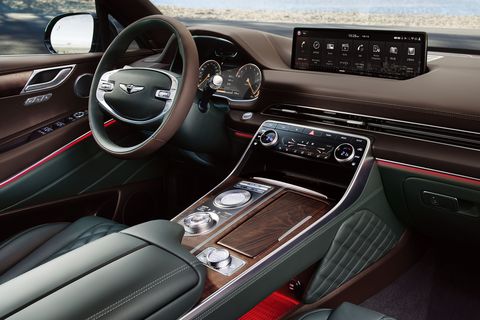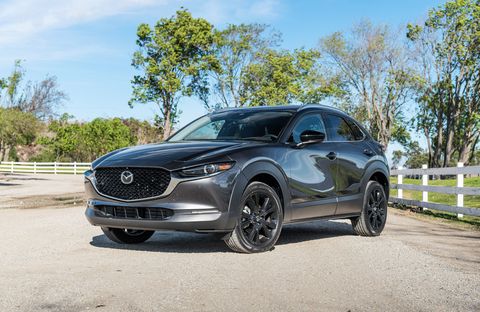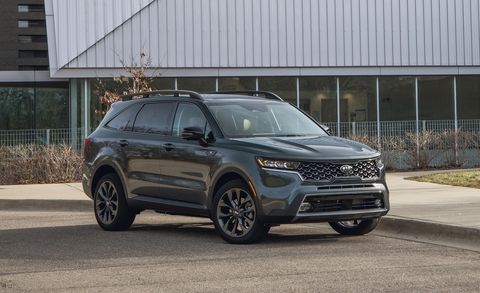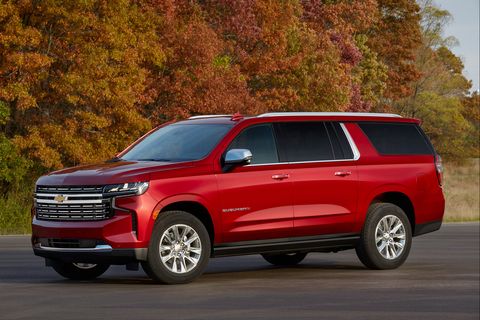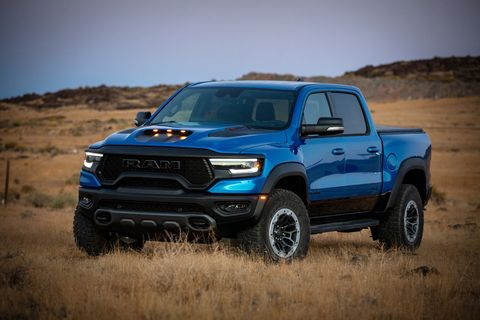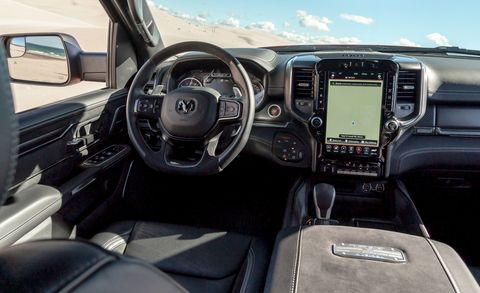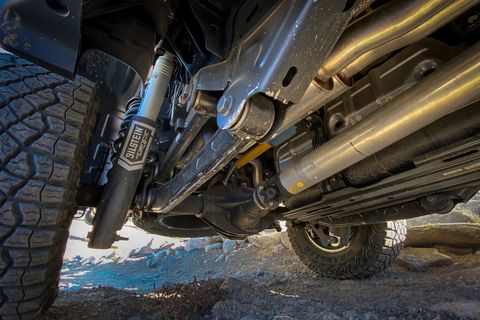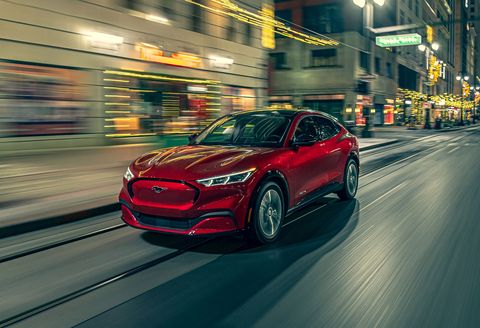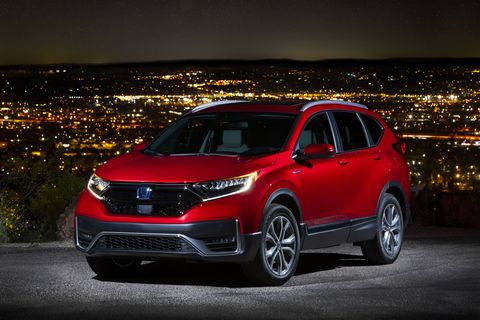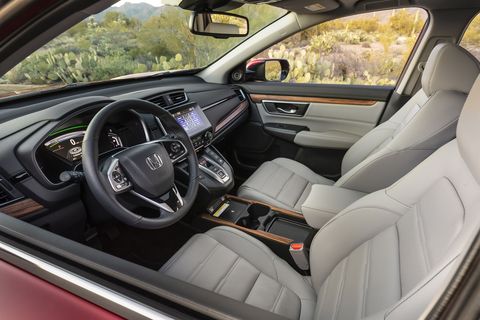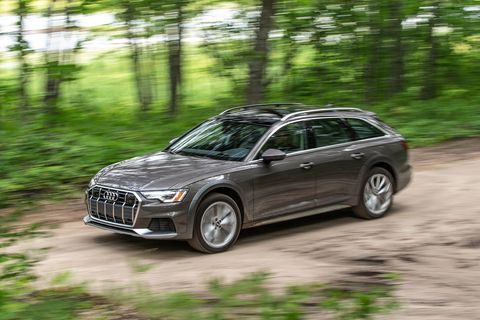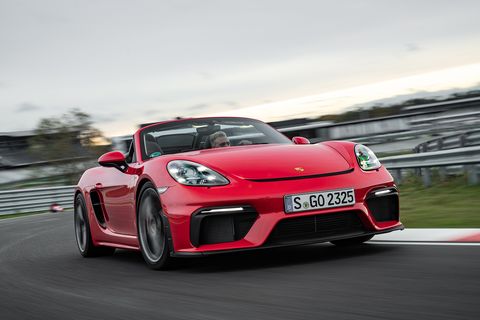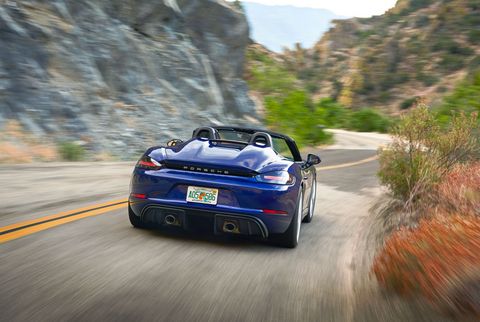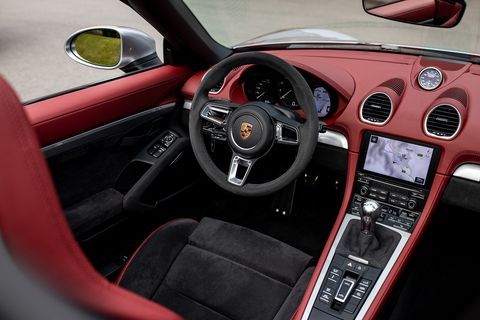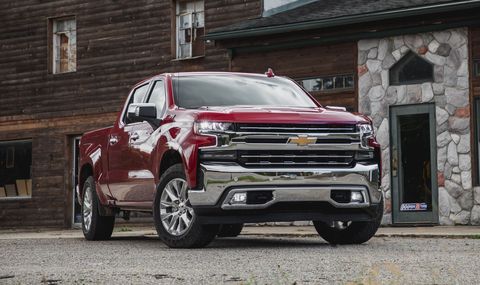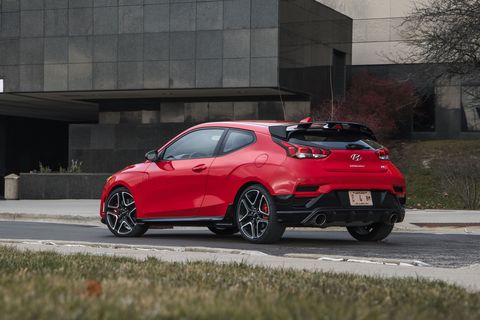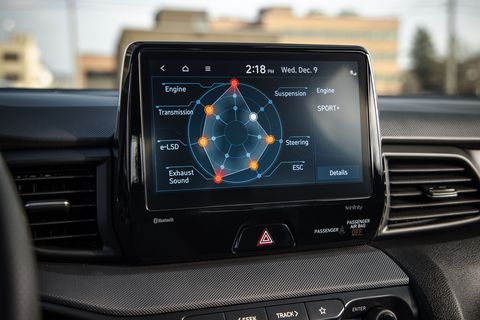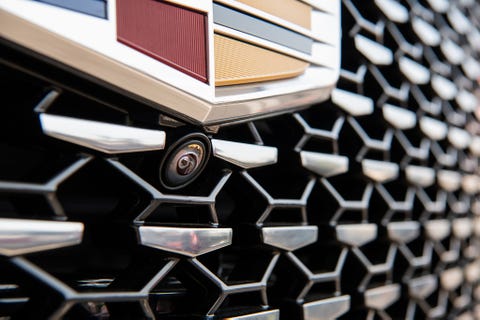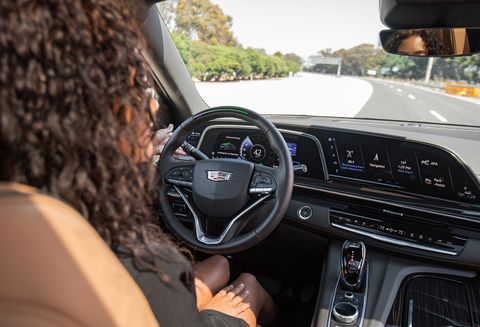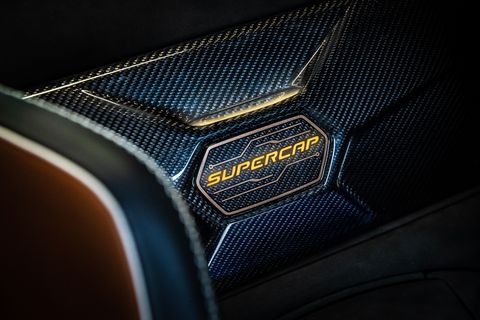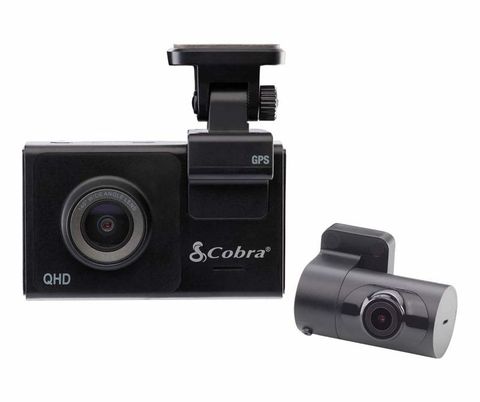Cars occupy a special place in the American psyche. Despite their ubiquity, we still tend to view them as signs of freedom, independence, and some degree of self reliance. And there’s basis for that. A sedan can be your escape, a way to get out and enjoy the road. An SUV can shuttle kids to soccer games, you to work, and everyone plus groceries back home. And a van can even be a mobile place of business, the rolling base from which tradesmen and women ply their crafts.
Our editors and testers spend many hours driving thousands of miles to determine which vehicles best fit those (and other) roles. Here, in our 2021 Automotive Excellence Awards, you’ll find the results, along with recent developments in car design that will make driving easier and more exciting. Plus, we’ve included our evaluations from testing several key categories of accessories, to lend you more of that self reliance when you’re out on the road.
Vehicles
Volkswagen ID.4
Genesis GV80
Chrysler Pacifica Hybrid
Mazda CX-30
Kia Sorento
Chevrolet Suburban Diesel
Ram 1500 TRX
Ford Mustang Mach-E
Honda CR-V Hybrid
Audi A6 AllRoad
Porsche 718 Spyder
Chevrolet Silverado Crew LTZ 4WD
Hyundai Veloster N
Tech and Engine Developments
GM Super Cruise
Lamborghini Supercapacitor
And A Plea for Better Infotainment Systems
Vehicles
Volkswagen ID.4
Base price: $39,995 | Motor: 201 hp, 229 lb-ft | Transmission: 1-speed direct-drive | MPGe: 104 city, 89 highway, 97 combined
Volkswagen’s ID.4 is an admirable show of restraint from the German automaker. While the small SUV lacks some of the awe-inspiring tech and driving capabilities of others in its class, it’s because of that that it feels more approachable, especially to first-time EV drivers.
Take the dash. It’s blessedly uncluttered, with only a single infotainment screen for operating functions like the climate control and music, and a small screen above the steering column serves as the gauge display. The main screen is somewhat tricky to navigate, though, and we were hesitant to try changing much of anything with it while the ID.4 was in motion. But the driving is easy; one knob changes gears, and notifications like the side-alert lights are big and noticeable. The ID.4 is very gas-engine-like in its manners as well. It creeps forward when you let off the brake and coasts without a ton of regenerative braking drag. Accordingly, the car doesn’t have the zip many drivers familiar with EVs have come to expect of them. But it has enough that it made a passenger—one who’d never ridden in an electric car before—sit up a little straighter during one of our test drives. The SUV felt planted and predictable on the road—both good things in a car this size. Rear-wheel drive is standard, but available all-wheel drive adds a second motor between the front wheels. The lane-keeping assist did take some getting used to, as it ever so slightly nudged the wheel back toward the center if we strayed too far to one side of our lane. It gave the impression that the car was fighting against us, but we eventually came to appreciate it keeping us true.
Volkswagen claims that the ID.4 Pro S gets an EPA-estimated 250 miles on a full charge, but the gauge only ever told us a little more than 230 at 100 percent. And that’s less than many other cars in this class. When we took the car to a DC fast-charging station, it went from 30 percent to full in about an hour and ten minutes.
Other than that, the ID.4 has the space you’d expect in a small SUV, with a comfy second row and ample room in the trunk.
It has its downsides, but in the ID.4, VW has made an EV that could draw more drivers into the electric fold, welcoming them with a familiar feel and features while opening them up to the ever-growing potential of the category.—Will Egensteiner
Genesis GV80
Base price: $49,945 | Engine: Turbocharged 2.5-liter V6, 375 hp, 391 lb-ft | Transmission: 8-speed automatic | MPG: 18 city, 23 highway, 20 combined
The GV80’s gear selector dial, the steering wheel thumb buttons, the knob to adjust the windshield wiper speed—every surface that you touch has the texture and substance of an expensive mechanical watch. Blindfolded, we would have guessed the interior was made by a European company and sold for six figures. It makes sense that a VP of design at Hyundai Motor, Genesis’s parent company, came over from Bentley.
Luxury materials aside, the first Genesis SUV still has the core characteristics that have endeared us to the sedans that precede it. For one, the adaptive cruise control is among the best in the industry. It’s one of the few systems that will completely stop in traffic, then start again—though, if you’re at a standstill for more than a few seconds, you need to tap the accelerator to move. We also like the optional blind-spot cameras: When you activate your blinker to change lanes, one of the dashboard gauges turns into a live video feed of that side’s blind spot. We wish every car had both.
The standard four-cylinder (23 mpg) and optional V6 (20 mpg) engines will both do zero-to-60 in around 6 seconds. That’s faster than most competitors, and enough to feel confident on highway merges. The front and rear multilink suspension minimize body roll in corners. And count us among the fans of the weird two-spoke steering wheel and the counterclockwise tachometer, which we’ve only seen in Aston Martins.
Somehow, even the things that don’t work in the GV80 actually kind of work. The flush scroll wheel for the center screen is difficult to use at speed, but feels like the volume knob on an expensive stereo. The optional third-row seats are impractically small for anyone except children. We’d skip them and get the spare tire instead. But those seats have power reclining, cupholders, and full-size climate vents outlined in knurled metal. You can even raise and lower them from the driver’s seat, using the center screen, perfect for curbside pickup. The GV80 is just full of that sort of considerate functionality.—Alex George
Chrysler Pacifica Hybrid
Base price: $35,195 | Engine: 3.6-liter V6, 260 hp | Transmission: 9-speed automatic | MPG: 19 city, 28 highway, 23 combined
If you need to move people and their stuff, the default choice is an SUV. Maybe a supercab pickup. But before you buy a Chevy Tahoe or F-150, at least go see the minivans. They’ve come a long way, but you might not get it until you see it in person. The rear doors open and close themselves, like in a Rolls-Royce. Some of them come with vacuums. The rear seats can fold all the way down into the floor—though hybrid models’ batteries mean only the back row can perform this trick. You can even buy one with all-wheel drive.
The redesigned Toyota Sienna came close, and is still an easy recommendation. And the just-arrived Kia Carnival looks promising. But the Chrysler Pacifica won us over as the best example of everything modern minivans do well.
With our Hybrid test car, overnight charges from a 120-volt wall outlet gave us 30 miles of quiet, torquey all-electric driving, more than enough for daily errands. For all trim levels, lots of safety tech is standard: automatic emergency braking, blind spot sensors, adaptive cruise control, and a high-res backup camera with cross-traffic alert that is unexpectedly useful in crowded parking lots. You can outfit the cabin with an incredible 12 USB charging ports, some of which are USB-C and can power an iPad for the entirety of a trip. Our test car came with optional wireless CarPlay, which was responsive when operated through the 10.1-inch center screen. It took a dedicated search for us to find all the hidden storage bins throughout the back seats.
It’s even kinda fun to drive. The electric motor produces low-end torque that got us into narrow gaps in traffic, and the huge windshield provides almost Tesla-like visibility. If all all that isn’t enough to get buyers to embrace the minivan, we don’t know what will.—AG
Mazda CX-30
Base price: $29,900 | Engine: 2.5-liter, four-cylinder turbocharged Skyactiv engine, 250 hp, 320 lb-ft | Transmission: 6-speed automatic | MPG: 22 city, 30 highway, 25 combined
Last year, we named the CX-30 our Crossover of the Year. At the time, the then new model impressed with excellent driving dynamics, premium finishes and features, and a ride quality that surpassed its price. We viewed it as a well-made, fairly priced small crossover that met its users’ needs. We weren’t the only ones who liked it. It became Mazda’s second-best selling model.
For all it gets right, the 30 had a naturally aspirated engine that produced only 186 horses. It felt underwhelming, especially when compared to the car’s responsive steering and refined interior. The 2021 CX-30 solves that with a 2.5-liter turbocharged four cylinder that kicks out 250 horsepower and 320 lb-ft of torque when running 93 octane fuel. That’s more power and torque than almost any other vehicle in its class, that includes models like the Subaru Crosstrek and Hyundai Kona—but it’s also not a stretch to compare it to more premium options like BMW’s X1 or Audi’s Q3.
It’s thumpy and responsive, but also tuned to be a bit less jumpy than what you get with some other turbo options—you only get a real kick from the engine at higher RPMs. The rest of the time, the engine feels powerful and pleasing, but not overwhelming. That speaks to Mazda’s intent with this car. It’s not a hot hatch or weekend racer. Practicality still trumps speed with the CX-30.
Mazda packs every turbo with heated front seats, a power moonroof, auto-dimming rear mirror, and a nice set of safety features that includes lane-departure assist, blind-spot monitoring, and braking assist. That’s a lot to love. If the marque of a vehicle is less important to you than what it offers—and that’s a lot of what Mazda is going for—this Turbo stacks up favorably to more expensive options.—Lou Mazzante
Kia Sorento
Base price: $29,390, LX; 34,990, EX turbo | Engine: 2.5L turbo, 281 hp, 311 lb-ft | Transmission: 8-speed dual-clutch | MPG: 22 city, 29 highway, 25 combined
With 0 to 60 times in the low sixes, a refined interior, and a muscular, modern silhouette that is more exciting than the vehicle it replaces, Kia’s new Sedona deserves its spot among the best mid-size SUVs with third-row seating.
The previous Sorento lagged in design and performance—so bland that it looked like it could have been molded from soggy cardboard. It was perfectly harmless but tragically unappealing. This one though looks like it’s been on a 90-day muscle-building boot camp. The exterior is more defined, with sharper lines and more daring curves.
The motor got a workout too. Kia dropped a new 2.5-liter turbo into the EX and SX versions that cranks out 281hp and 311 lb-ft of torque. It’s fast and gutsy and it makes the Sedona satisfying to drive—rare among vehicles in this class. The dual-clutch transmission delivers quick shifts that complement the turbo’s pop. It’s a new system, and some shifts feel delayed. It’s more quirky than concerning though.
Several versions allow you to choose second row Captain’s chairs, which easily slide forward or fold down to create more cargo space. The third row is more cramped and best to think of it as an emergency option when you have a larger group; if you regularly need to seat adults in a third row, the larger Sedona may be a better option.
The AWD SX Prestige edition we tested came with 20-inch wheels, comfortable and attractive leather seats, a massive panoramic sunroof, and a 10.25-inch entertainment console that was intuitive to use (though you need a USB cable to connect to Carplay or Android Auto). It’s comfortable and attractive. Not quite luxurious, but close enough to make the price reasonable.—LM
Chevrolet Suburban Diesel
Base price: $57,990 | Engine: 3.0-liter turbo diesel, 277 hp, 460 lb-ft | Transmission: 10-speed automatic | MPG: 21 city, 27 highway, 24 combined
The 2021 Suburban that rolled out over the summer had two eight-cylinder engine options: a 5.2-liter or a 6.2-liter, each available in 2WD or 4WD. Now, the company adds a third option: an inline-six Duramax diesel that puts out 277 horses, and 460 pound feet of torque, the same performance as the 6.2-liter non-diesel V8 option. And all of that torque is available at just 1,500 rpm, making the engine’s power more accessible. For comparison, you have to hit 4,100 rpm to get all that torque in the eight cylinder model. That translates to smooth driving at highway speeds and more effortless towing, without the jumping through gears that can happen with gas engines.
There’s some appealing fuel savings too. The 2WD diesel gets an EPA-checked 23mpg (combined city and highway) and the 4WD gives you 22mpg. That makes it the most fuel efficient SUV available. Our test drives came in just under that, about 19mph in the city and 26 on our highway loop at a steady 65mph. We didn’t tow anything during our review, but we could see the diesel engine’s benefits for that purpose. When we hit steeper grades on the interstate that typically send vehicles jumping through gears, the Suburban remained calm with RPMs holding steady at 1,600 as we pushed up at 67mph.
At just under 19 feet and a turning diameter of 43.3 feet (with the 22-inch wheels on our test RST model), the Suburban is a lot of vehicle to control. On the road, it’s predictable and relatively easy to manage. The steering feels accurate and requires just a light touch. A suite of safety and drive-assist features are also welcome. Up to 9 cameras, parking assist, and front-pedestrian braking are especially helpful on a vehicle this size. The hood also has a slight forward slope, which improves forward visibility. However, we measured an 11-foot blindspot ahead of the vehicle (using a 30-inch-high dummy). That’s about twice as much as some mid-size SUVs we’ve recently tested.
If you have to fit three rows of passengers, tow a trailer, and want better fuel economy than the competition, the diesel Suburban meets every criteria. And if you’re already sold on a Suburban, the cost for the diesel upgrade is only about $1,000 over the gas models (and $1,500 less than the premium High Country spec with a V8). Not everyone needs what the diesel Suburban provides. But for those who do, it’s the best option we’ve seen so far.—LM
Learn More Read Full Review
Ram 1500 TRX
Base price: $71,790 | Engine: 6.2-liter V-8, 702 hp, 650 lb-ft | Transmission: 8-speed automatic | MPG: 10 city, 14 highway, 12 combined
Last year, when we gave the base Ram 1500 an Automotive Excellence award, we called out its many features friendly to the men and women who work with tools for a living and its high-end interior in a class of truck that’s consistently marrying luxury with gritty capability. No surprise, then, that the TRX takes all that and does it up to the nth degree.
First, under the hood. The Hellcat engine boasts some serious horsepower and torque numbers. And when our friends at Car & Driver put the TRX through their zero to 60 test, it made the speed jump in a blistering 3.7 seconds—especially impressive given the truck’s bigger and heftier dimensions than the standard 1500, which took more than twice that time to accelerate to 60 mph. Do you necessarily need a truck to go that fast? No. Do we appreciate the engineering that went into getting a machine this size to move that quick? Of course. With power going to all four wheels, the TRX can tow up to 8,100 pounds, and it’s capable of carrying 1,310 in the bed.
Inside, the truck has a prominent 12-inch touchscreen. That, combined with the many physical buttons, can be overwhelming, giving the dash a very busy appearance. But those hard buttons may be a comfort to some. More interesting than immediately useful during our testing: There’s one screen that shows you where the power is going in the drivetrain at any moment depending on the drive mode. You can splurge for things like a digital rearview mirror and heated seats if you like.
On the road, the crew cab, short bed TRX feels massive, though the acceleration helps it avoid tipping over that line into sluggish. Where the truck further differentiates itself from the base 1500 is in its off-road chops. Ground clearance of 11.8 inches, suspension with 13 inches of travel, 35-inch all-terrain tires on 18-inch wheels, and an electronic locking differential all contribute to its capability there. Where it suffers, though not necessarily because of those traits, is in fuel economy—12 mpg combined compared to the 1500’s 24.
Most drivers in the market for a truck like this will get their money’s worth out of the regular 1500. But if having more power and capability when you venture off the pavement is important, you won’t find better than the TRX.—WE
Ford Mustang Mach-E
Base price: $47,600, Premium Edition | Engine: Electric AWD, 346 hp, 428 lb-ft | Range: 270 miles, AWD w/ extended battery
Whether you agree with Ford’s choice to call this a Mustang or not, it’s hard to deny the logic: Put the brand’s most exciting marque on its most exciting new vehicle. You’ll have to look inside the owner’s manual to see Ford written anywhere on this Mustang. And to be clear: this is one exciting vehicle.
The model we tested had Ford’s extended-range battery option and all-wheel drive. In that configuration, you can go about 270 miles on a charge with easy driving. But it also will go from 0-60 in under 5 seconds, so you probably won’t drive it that easily. Faster versions are on the way. It’s got plenty of power (about 330 hp in our configuration) and decent torque, but it weighs just over 4,800 pounds making it feeling stable even as you’re accelerating.It handles accurately for a heavy, quick vehicle, and the brakes are remarkably powerful, adding even more control.
The interior is as roomy as most crossovers, with plenty of head and floorspace in the rear. Plus the frunk is made of plastic and has a drain so you can use it as a cooler if you like.
Ford claims the Premium model will charge at speeds up to 150kw/h, but we typically got about 50 to 60 kh/w even at dedicated fast-charging stations.
The 15.5-inch touchscreen makes accessing vehicle settings, entertainment system, and some controls easy. And it gives you a huge screen to view backup, parking, and 360-degree vehicle cameras. The mounting point, in front of the center console isn’t ideal, but not much of an issue—the screen size makes up for the poor sightlines.
The Premium Edition version we tested costs more than a comparable Tesla Model 3 (though has some extra features like AWD), takes longer to charge, and it doesn’t yet drive itself, though that may be coming in an update later this year. Yet there’s a level of refinement here, of consistently executed quality and overall driving satisfaction that makes this a fierce new EV competitor.—LM
Honda CR-V Hybrid
Base price: $30,560 | Engine: 2.0-liter inline-4, 212 hp | Transmission: 1-speed direct-drive | MPG: 40 city, 35 highway, 38 combined
The CR-V has never been one for flash, just reliability. But don’t take our use of “just” there as a dig at this crossover. There wasn’t one thing about the vehicle that made us sit up and take notice. It has the kind of overall capability to do what you need it to, and do it well, without demanding much of the driver or calling attention to itself. During our test of the hybrid, all-wheel-drive version involving a long weekend spin through Pennsylvania, it was nimble and drove smaller than its 182-inch length and 73-inch width would suggest, with the satisfying acceleration that comes via partnered in-line four-cylinder engine and battery-powered operation. And cargo space was just north of 33 cubic feet—pushed to 68.7 with the rear row down—easily enough for a weekend’s worth of gear or running everyday family errands, and toward the top of the class for CUVs.
Sure, we averaged in the low 30s for mpg during our time with the CR-V—a bit less than we would have liked in a hybrid driven mostly on the highway. And the exterior sensors could be a little touchy, while the interior detectors (like the ones that alert you if your attention is lagging) were hit or miss. The car’s safety, assistance, and all-around convenience are hard to deny though. Honda has planted this bestseller in the middle ground, and it makes a lot of sense for a lot of people, especially with a starting MSRP of $25,350 for the base (non-hybrid) package.—WE
Audi A6 AllRoad
Base price: $66,895 | Engine: 3-liter V6, 335 hp, 369 lb-ft | Transmission: 7-speed automatic | MPG: 20 city, 26 highway, 22 combined
In the A6, Audi has made a station wagon that has several identities: practical daily driver, fun performance machine, and occasional beyond-the-pavement adventurer. Often when one vehicle tries to be so many things, it runs into the jack of all trades, master of none curse, and noticeable compromises arise. But the A6 seems to have avoided much of that through a combination of smart engineering, intuitive controls, and all-around capability—all of which is reflected in the hefty starting price tag.
Starting with its everyday capability, the A6 is easy to get the hang off for all it has going on, especially on the busy dash. The car has two screens—one for all the menus and one dedicated to climate control—which can appear intimidating. But having the A/C and heat set aside in their own screen provides quick access and reliability coming close to that of physical buttons. And after a couple of drives, we felt comfortable navigating through the A6’s essential functions right from the buttons on the steering wheel and the gauge display. We tested the Prestige trim, and befitting a nearly $75,000 car, there are some extravagances that, while nice, you’d be better served forgoing to keep the price down. Things like massage seats and colored interior lighting. But perks like surround view for parking due add to the practicality and ease of use. For storage, there’s 30 cubic feet of space in the back. Plus, our colleagues at Car & Driver eked out 34 mpg in their highway fuel economy test, up from the EPA’s estimate of 26.
In the performance realm, the turbocharged V6 delivered peppy acceleration, facilitating confident lane changes and navigation of traffic. We found ourselves relishing windy roads, on which the A6 felt planted and responsive. And all-wheel drive comes standard, which also plays into the capability for light offroading. The wagon has an adjustable air suspension, and the highest setting boosts the car 1.2 inches for additional clearance. You’re not going to take the A6 rock-crawling, but for gravel and rutted forest roads, it should do just fine.—WE
Porsche 718 Spyder
Base price: $98,300 | Engine: Boxer 6, 414 hp, 309 lb-ft | Transmission: 6-speed manual | MPG: TBD
We drove the Ferrari F8, the Lamborghini Huracán EVO, and the Porsche 911 Turbo S. As engineering marvels and collector investments, they’re masterpieces that are somehow worth the outrageous asking prices. But for selfish driving pleasure, they’re too much, at least in the United States. After a second on the accelerator, you’re watching for speed traps. Or, the automatic transmissions have you in 7th gear, to keep the exhaust sound from deafening pedestrians. None of those cars made us seek driving adventures the way we did with the slower, less-powerful 718 Spyder.
Of its numerous qualities, the naturally-aspirated flat-six engine and manual six-speed are what make the 718 special—and the Boxter GTS, Cayman GTS, and GT4, which all have the same dream pairing. The dual-mass flywheel absorbs vibrations, so gear changes feel precise. And when you downshift for a turn or traffic, the auto-blip system revs the flat-six engine to the right RPM, so power is ready, no heel-toe tap dancing required. It’s a near-ideal ratio of analog engagement and computer augmentation. That level of control and available power (414 hp) feels especially magical from within the 718’s compact dimensions—about 20 inches longer than a Mazda Miata, but only an inch or two wider and taller.
All-electric cars like the Taycan and performance hybrids like the McLaren Artura and Acura NSX are faster, and help their manufacturers comply with overdue and necessary emissions regulations. No, Porsche won’t stop selling big-displacement, manual-transmission coupes and convertibles next year, or even five years from now. But the era for cars like this feels finite. If we had to choose a last-ever analog thrill machine, the 718 would be a worthy sign-off.—AG
Chevrolet Silverado Crew LTZ 4WD
Base price: $52,400 | Engine: Duramax 3.0L turbo diesel, 277hp, 460 lb-ft | Transmission: 10-speed automatic | MPG: 22 city, 26 highway, 24 combined
We’re fans of the Duramax diesel that Chevy made available in its Suburban family SUV this year and like it just as much in the Silverado. The 277 horsepower isn’t bad, but it’s the torque that gets us: 460 lb-ft and it’s all available at 1,500 rpm. That makes hauling big loads and towing heavy things easier. Paired with a 10-speed automatic transmission, the Silverado glides up grades without any downshifting to find the right gear
The powertrain is a welcome addition to Chevy’s line. It’s the first time this millennium that Chevy has offered a diesel in one of its light-duty trucks, and it’s the first-ever inline six in that range. The Duramax brings exceptional towing capabilities and fuel economy. The version we tested with four-wheel drive can tow 9,300 pounds and has a max payload of 1,870 pounds. When free of those chores, the Silverado gets a combined 24mpg.
You have to step up to one of the Silverado’s premium packages to access the diesel, which puts the price of entry at about $50k. On the lower trim levels, the diesel motor is a $3,800 upgrade over the gas engine. Compared with the also-exceptional Ram 1500, the Chevy is a bit less refined inside, and not quite as pleasing to drive. But we value practicality and can-do here, and that’s where the Duramax-equipped Silverado excels. If you’re using your truck often for towing and hauling, you can’t beat this one.—LM
Hyundai Veloster N
Base price: $32,520 | Engine: 2-liter inline-4, 275 hp, 260 lb-ft | Transmission: 6-speed manual | MPG: 22 city, 28 highway, 25 combined
The Veloster N is one of few cars we tested this year, at any price, that could handle a Home Depot run, and make you look for a longer, more winding route back home. We get why Road & Track chose it as their Performance Car of the Year, over a McLaren, Lotus, and the mid-engine Corvette. The Veloster is a blast.
The numbers are typical for a front-drive hatchback. A 2.0-liter turbocharged inline-four produces 275 horsepower, which feels sufficient for its 3,186 pounds. Zero-to-60 happens in just over 5 seconds. In practice, we liked being able to comfortably sit in traffic in Eco mode, then exit onto back roads and switch to on N mode for louder exhaust, faster throttle response, and stiffer suspension. N mode also makes the steering wonderfully tight. That feedback makes you feel like a rally driver as you exit the mall parking lot.
Our test car had a dual clutch automatic transmission, a $1,500 option new for 2021. Car & Driver reported a 4.8-second zero-to-60 with it, and in our daily driving through stop signs and parking lots, its smoothness was a testament to how far automatics have come. But we’d take the speed penalty and get the six-speed manual for the full experience.
The Mazda3 2.5 Turbo is excellent, but the Veloster has much better rear visibility. And the new VW Golf R will have 40 more horsepower, but will also cost over $10,000 more. And neither has Hyundai’s 100,000-mile powertrain warranty. The Veloster N exemplifies the affordability, practicality, and thrill that hot hatches promise.—AG
Tech and Engine Developments
GM Super Cruise
Super Cruise isn’t exactly new. It was back in 2013 when General Motors first announced the tech, and we were sufficiently impressed with the system—which is akin to highway autopilot—then to the point that we gave it a Breakthrough Award. And after years of refining, during which Super Cruise debuted on the 2018 Cadillac CT6, GM is bringing it to the Chevy Bolt EUV. We can attest, following a recent test drive on crowded New Jersey highways and winding suburban roads, that the tech is living up to its promise.
Now, Chevy is clear in stating that Super Cruise is only a driver-assistance feature, so you can’t just turn it on and start scrolling through social media on your phone. But we found it incredibly easy to use—especially appreciated given that tech like this has the potential to easily intimidate or overwhelm. It operates in much the same way that cruise control does: Once we were centered in the lane, an LED embedded in the top of the steering wheel turned green, signaling that the system was ready to take over; we then pressed a button on the wheel, and the car, via a suite of cameras and GPS navigation, kept us in the middle, automatically braking and accelerating so we stayed at a set distance from the car in front of us. When we needed to change lanes, we simply hit the turn signal, the light on the wheel turned blue (signaling that it was ceding control temporarily), and we shifted over before letting go of the wheel again and letting the system pick up where it left off. The LED turned red when Super Cruise was turning off, alerting us that we needed to take the wheel again.
Though the system is constantly making adjustments, there was no ping-ponging effect, as if the Bolt was drifting toward one side of the lane before its cameras picked up the line and redirected it back until it hit the opposite one. Even approaching rush hour on Interstate 287, the Bolt was composed as cars flanked us and traffic ebbed and flowed. It was a trippy experience, and took some building of trust between us and the car, but we quickly became comfortable letting go of the wheel. We sat back and let the Bolt drive for ten-minute chunks at a time, knowing that if we had to, taking back the helm was easy.
GM currently has about 200,000 miles of highways mapped for use with Super Cruise (it only works on certain roads). And the system epitomizes “driver assistance”—making our time on the road easier in an accessible way.—WE
Lamborghini’s Supercapacitor
Same as the lithium-ion batteries in an iPhone or Tesla Model 3, a capacitor is a way to store energy. While batteries store that electrical energy as chemicals, capacitors hold that electricity as an electric field—two metal plates, an anode and a cathode, separated by an insulator.
For electric cars, conventional batteries win. You would need an impractically huge array of capacitors to hold enough charge just to get to the supermarket. But for building the fastest ever Lamborghini to date, capacitors win.
While they can only hold a fraction of the energy you can keep in a battery, capacitors can recharge and discharge more quickly. A corner’s-worth of braking can give the Sián’s capacitor enough charge to brutally accelerate into the next straightaway. (They’re also lighter than batteries). Those qualities are useful when building a car for which success is measured in lap times and top speed rather than range.
That electric torque is there to fill in until the naturally aspirated 6.5-liter V12 winds up enough to take over. That low-end power should also compensate for the clunky single-clutch gearbox also found in the Aventador on which it’s based.
It all makes sense. Of course Lamborghini’s first hybrid would use esoteric technology, cost $3 million, and go 220 mph. No other company is so well qualified to build the antithesis to the Toyota Prius.—AG
And a Plea For Better Infotainment Systems
Every car I test, from $30,000 to $300,000, I have the same routine. I try the voice commands, add some favorite SiruisXM stations, and set the driver assistance to where I like it, and try to create a menu shortcut for the seat massagers. I’ll run errands using the built-in navigation system. But otherwise, it’s Apple CarPlay, mostly Google Maps and Spotify. Because no car manufacturer is going to build a user interface that’s as intuitive as Apple’s.
That’s what makes the 2022 Mercedes-Benz EQS look like kind of a nightmare. It has screens for every occupant, including the rear middle seat, which gets a pop-out Samsung tablet. Each one will be annoyingly slower than the screens already in the pockets and purses of people who can afford a $100,000-plus car. Designing and building cars is a multi-year process, so a brand new model always uses outdated processors and LCD panels. That’s why, on almost every new car, you tap…wait…swipe…wait as you move through menus that look like they were lifted from Windows XP.
Unlike refrigerators or thermostats, smartphone-like screens and menus will always be necessary in modern cars. There’s just no other way to adjust everything you might want to adjust. But please, while we’re driving, keep those screens simple, and leave a few buttons. As long as drivers need to actually look at the road while driving, tapping a + icon will always be more annoying (and more dangerous) than turning a volume knob.—AG
The right accessories can only make a car better and, in some cases (see the dash cams and jump starters below), even save it from dents, trips on the back of a tow truck, and insurance claims. We at Popular Mechanics have been testing and otherwise evaluating the best for decades now, and we can confidently say out of what’s new on the market for 2021, what follows are the best. but first, a look into our methodology.
How We Tested and Selected
With such a broad range of automotive accessories (and we use that word liberally, since we’ve covered things like tires here), we had to take several approaches.
For headlight restoration kits, we paid a visit to our favorite auto salvage-recycling yard, Scarpati’s in Trenton, New Jersey, and asked to pick out three badly degraded headlight assemblies. And our procedure was pretty simple. We first cleaned all of the lenses with water or household spray cleaner to remove dirt. Then we applied the products strictly per the instructions. Our tests showed that lens restoration products quickly restore a dulled, yellowed, and scratched lens. They can’t address dust, condensation, or sunlight-related degradation on the inside of the lens or on the reflector.
Next, for vacuums, we used them on hard surfaces like concrete and vinyl floor to soft surfaces such as carpet. We picked up hair, dust, dirt, and sawdust. The final portion of the test was the most rigorous. We mixed one pound of sawdust, floor sweeping compound, small nuts and bolts, washers, and dried kidney beans. Then we timed how quickly each vacuum pulled in this test material. Small models typically reached capacity in about eight seconds, while those with larger debris containers took about 20.
As we mentioned, tires are a different animal. We hit up Woody Rogers, VP of marketing (and former director of tire information) at Tire Rack, for some specific recommendations across a few popular classes of tire. Tire Rack conducts its own in-house comprehensive testing (and compiles thousands of real-word consumer reviews), so Rogers knows of what speaks.
Then came jump starters. We tested all of these units by first ensuring they could perform their primary function: jumping a car’s dead battery. We did that by putting a completely kaput battery into an old Honda Fit; that battery had so little power it failed to even illuminate the dome light, and the car wouldn’t crank at all. Then we tested each of the jump starters, and each enabled the Honda to immediately crank over and start. For the below reviews then, we focus mostly on the other attributes of each unit so you can decide what extras you need or want.
And finally, dash cams. Since the bulk of newer cars already have backup cameras (and that’s now a federal requirement) we focused on dash cams that also connect to either interior-facing or rear-facing cameras that let you see the entirety of the road behind your car. We also sought features like night vision, easy controls and phone pairing, parked-car monitoring and auto-on g-force sensors that would record accident footage without needing input from the driver.
—HEADLIGHT RESTORER—
Sylvania Headlight Restoration Kit
This kit left the test headlight clearer and newer-looking than any of the others. Be warned: It was also the most time-consuming process. All you need is a clean towel and a hose for this one, everything else is provided in the box for you. The tested light showed a massive improvement over the cloudiness from the beginning, with the only downside being a long four-plus hour waiting period for the UV protection to take effect. Sylvania offers a lifetime warranty, claiming that your lights will stay clear for the life of the car with its kit.—Roy Berendsohn
—CAR VACUUM—
Black & Decker Dustbuster HHVK515J
Weight: 2.6 lb | Built-in battery: Yes | Volts: 20 | Accessories: Nozzle slides out, but no accessories
Light, easy-handling, and plenty of power: Those were the three strengths that helped this 20-volt Dustbuster ride to victory. Sure, other vacs we tested had more power, but the Dustbuster has more than enough oomph to get the job done. In fact, we think it’s an excellent product to cross among jobs in the home, the shop, and cleaning out the car’s interior. Its nozzle extends an additional 7.5 inches—all you have to do is pull it forward. Although we did notice that the sliding action of the extension is a bit sticky, and coarser particles left scratches on the nozzle. But it’s still a very helpful feature. Like its smaller 12-volt colleague below, the HHVK515J is easy to empty and has low and high speed settings.—RB
—TRACTION ALL-SEASON TIRES—
Michelin CrossClimate 2
Take a look at the tread pattern of the CrossClimate 2 and it’s clear, this aggressive all-season is designed to work well in the snow. The “Premium Traction” class of all-season tires really prioritizes inclement weather traction. And Rogers says this Michelin works very well. “They’ve done a lot of work on the compound and refined the tread pattern in terms of angles, spacing, notches, and grooves to aid drivability in the snow,” he says. Indeed, the CrossClimate 2 carries the 3 Peak Mountain Snowflake on the sidewall, which means it has met a minimum level of snow traction set by the U.S. Tire Manufacturers Association (USTMA) and the Rubber Association of Canada (RAC). Those driving crossover SUVs and minivans can opt for the CrossClimate SUV rated for larger vehicles. “You still won’t beat a winter tire on the ice,” says Rogers. “But they are continuing to incrementally push the snow traction boundary, and these will satisfy a lot of people, particularly those a little lower in the snowbelt.”—Ben Stewart
—ALL-SEASON COMFORT TIRES—
Bridgestone Turanza Quiettrack
This class of all-season tires delivers maximum comfort and quietness. Bridgestone says there’s a 20 percent improvement in wet traction and 44 percent in snow traction over the previous generation Turanza Serenity Plus tire. Yes, it’s a very good all-season tire than can handle snow. But it’s simply a more pleasant tire to drive in every other road condition, too. “Cars are quieter today, so there’s clearly a desire for smooth and quiet all-season tires,” says Rogers. “And Bridgestone has found a way to deliver comfort and quiet without really sacrificing good snow and wet traction.”—BS
—DEDICATED WINTER TIRES—
Bridgestone Blizzak WS90
When the weather turns, nothing beats a dedicated winter tire for traction on snow and ice. And Rogers says that Blizzak leads the category and has for many years. “They own the winter market,” he says. “The WS90 provides a nice incremental improvement over the WS80 in snow and ice traction but also made a real step change in the wear life of the tire.” Bridgestone says you should be able to get an additional season out if the WS90 compared to its predecessors. So really, you’re amortizing the cost of the winter tires over a longer period and extending the life of your other tires, too.—BS
—MOST RUGGED JUMP STARTER—
Noco GB70
Weight: 5 lb | Amperage: 2,000 | Ports: USB in and out, 12 volt in and out
The five-pound, 56Wh GB70 is very tough. We drop tested it from eight feet onto a gravel driveway, and its casing didn’t even show a scratch. Its alligator clamps are clearly built to last, too, with an extra sturdy, thick plastic exterior that’s grippy enough to use if you’re wearing work gloves. While the GB70 isn’t as compact as the Halo, below (don’t even try to fit it in a small glove box), its shell would clearly endure living in a truck-bed toolbox, bouncing around and laughing off the abuse. An integrated 400-lumen work light was intense enough to use as to brighten a car’s engine bay, and the beacon also has emergency flash modes. The unit features one 12-volt output as well as a single USB. Something to note for people who may want a versatile jump starter: This one has no 110-volt (wall jack) output, making it unsuitable for re-juicing a laptop or other home accessories.—Michael Frank
—BEST VALUE JUMP STARTER—
Halo Bolt
Weight: 1 lb | Watt hours: 58.8 | Ports: 2 USB, 1 AC
The tradeoff between the 58.8Wh Bolt and the Noco comes largely down to whether you want a rugged unit that’s heavier and can take a beating or whether you need a smaller, lighter charger (2.8 pounds) that can easily squeeze into a car’s glove box or even on-door pocket or center bin. For the latter, this Halo wins. It doesn’t hurt that it’s also cheaper and has both two USBs and a 115-volt wall-style outlet, which enables one full charge of most laptops. While the built-in light is bright, it has no lower setting or warning/flashing modes. And we found the alligator clips that connect to the poles of a battery to be slippery. Also, the wires are short, making threading to a car battery in the back of an engine bay a bit of a delicate operation.—MF
—BEST DO-EVERYTHING JUMP STARTER—
Schumacher FR01337
Weight: 22.6 lb | Amperage: 1,200 | Ports: 4 USB, 1 AC
This 1,200-amp beast is ideal for camping and RVers. No, it’s not small, at 22 pounds and about the size of two car batteries. But it packs a ton of features. It has four USBs, a wall-style 110-volt AC plug, and a 12-volt plug as well. The wall output maxes out at 200 watts, so that may not be enough power to run a massive flat screen TV, but we had no problem recharging laptops and refueling the batteries for portable drills and sanders. We plugged in a house floor lamp and a small box fan, too; a fairly large Libratone smart speaker also topped up without a hitch. You can also plug in, say, a phone, while charging a smart speaker or powering a lamp, and the FR01337 seems to multitask that load easily. Also, it has a built-in air compressor as well. We used it to easily re-inflate a flat lawnmower tire. It does take longer to balloon up a flat car tire, but it managed that too, in just a few minutes. The large handle and super solid base, as well as rubberized cladding, do make the FR01337 tough. But given the size, easily balancing it on the fender of a car while jumping a battery can be a challenge.—MF
—BEST DASH CAM FOR NON-TECHIES—
Garmin Dash Cam Tandem
Resolution: 1440p | Field of view: 180 degrees | Extras: GPS, g-force sensor, smartphone connectivity, night vision, parking mode
What we love most about this Garmin is that it’s stupid-simple to set up and use. We paired our phone via the app (ideally you also purchase a phone mount for your dash so you don’t have to look down to see the video) and immediately saw footage on our phone screen. And there’s no pressing of buttons necessary. Instead we used super easy voice commands—“Okay, Garmin,” and then a prompt like “Save Video” to preserve footage, for instance. The “Tandem” name doesn’t mean that this unit includes a backup camera; it has a forward-facing one, as well as one that monitors the cabin. And it has night vision for the interior of the car, so you can see if your kids are flicking fries at each other on the way home from the drive-through. The tiny candy bar-size Tandem is unobtrusive and also has both GPS and g-force sensing. To test the latter, we slammed on the brakes (simulating a panic stop), and it captured the footage. Plus it stamps that video with a time and location. It also has a parked-car sentry mode. On the downside, a suction mount would be preferable to the adhesive-and-magnet system used here, for easier transfer between vehicles. And the lack of a built-in screen requires you to pair your phone to see what the cameras are capturing.—MF
—DASH CAM WITH THE BEST FEATURE SET—
Cobra SC 200D
Resolution: 1600p | Extras: GPS, g-force sensor, smartphone connectivity, night vision, parking mode
While the front-facing unit is larger than the Garmin Tandem’s (about the size of a GoPro), the best thing about the SC 200D is its color screen. That makes pairing this to a phone over Wi-Fi and Bluetooth—which you can still do—unnecessary for live viewing. Driving around during testing, we always saw what the camera was capturing right on that screen. And while a lot of units pair with a backup camera, most have to be wired into the license plate wiring harness and only give a bumper perspective. We dig this Cobra because its rear-facing camera is actually designed to be mounted to the rear window, so we had a clear view down the road behind the car. Cobra also includes a lot of bells and whistles, too, such as alerts for lane keeping and warnings if the driver ahead suddenly slams on their brakes. Like with the Garmin, the SC 200D records looped footage, writing over the previous video if you don’t go in to preserve something you want. But because it also senses g-forces, it will save accident footage with a GPS waypoint and a time stamp. And the cam will also run as a security monitor in a parked car for several hours (though since it doesn’t have a battery of its own, it’s possible your car will shut off its 12V accessory port to preserve power). Know that phone pairing isn’t as smooth as with the Garmin, and we found it easier to just remove the SD card and view video and stills on a computer rather than on a paired phone. A touch screen would be preferable to the multiple buttons and rudimentary on-device menu, too.—MF
—BEST VALUE DASH CAM—
Vava Dual
Resolution: 1080p | Field of view: 155 degrees | Extras: GPS, g-force sensor, smartphone connectivity, night vision, parking mode
No camera here has a cooler app. It took over our phone with a split-screen view, showing both the front and the rear, with time and speed superimposed. Like the Garmin Tandem and Cobra SC200D, the Dual makes loop recordings of a duration we could set ourselves and has very clear night vision, plus a g-force sensor to kick in the auto-record in the event of a wreck. And while app pairing is just as easy as with the Garmin, sometimes the video flickered in and out. Don’t worry; the captured playback is plenty fluid. FYI, as with the SC 200D, the rear camera is meant for mounting on the inside of the back window. Especially if you have a bigger rig, like a pickup, the ultra-wide perspective of both cameras is excellent for capturing the corners of your truck or SUV. You can also swivel the front camera from facing the windshield to the car’s interior, in case you want to use it as another pair of eyes on passengers. The suction mount is great for quick removal and makes it easier to transfer this Vava to another vehicle. One other very clever hack is that the power cord to the 12V has two big buttons on it; these let us quickly shoot video or stills with a quick press. Sure, voice control is nifty, but if the radio’s blaring, this is more reliable. Costing less than some of the pricier, higher-end models, this cam has some understandable compromises, lacking GPS and a few of the extras that come on the SC200D.—MF
—BEST DASH CAM-RADAR COMBO—
Cobra Road Scout
Resolution: 1080p | Field of view: 154 degrees | Extras: GPS, g-force sensor, smartphone connectivity
If you want both a dash cam and a radar detector, your windshield is going to be very crowded, obstructing the forward view. The solution is the Road Scout, which combines both functions in one smartphone-size unit. On the radar side, it let us set frequent locations on our route, things like red light cameras, which other users can mark and populate in the app. And that app made adjusting the settings easier than if we had to toggle through menus on the Road Scout itself. In our test, the radar seemed to filter out nearly all false alarms in the X-band range (like automated big-box store doors as we drove by) and caught Ka band police radar from over a mile away. (It also reads for laser and K-band.) The unit gave voice prompts when it identified a band, too, so we didn’t have to take our eyes off the road. And a mute button right on the 12V power point let us silence warnings if we wanted. The camera has a very wide field of view, similar to the Vava. FYI, it also has a g-force sensor for automatic recording in the event of a crash, night vision, and loop recording. There’s no park sentry mode, though (disappointing in a cam this expensive). And we found downloading video to the phone app slower than with the other models here.—MF
This content is created and maintained by a third party, and imported onto this page to help users provide their email addresses. You may be able to find more information about this and similar content at piano.io




